
 |
| You might also like: | All About Jewels Glossary: C | Rocks and Minerals Dictionary: A | Today's featured page: Chimpanzee Printout |
Illustrated Dictionary of Jewelry |
 |
||||||
| A | B | C | D | E | F | G | H | I | J | K | L | M | N | O | P | Q | R | S | T | U | V | W | X | Y | Z |
 AB AB stands for Aurora borealis (which means "northern lights"). Aurora borealis rhinestones have a special iridescent finish that shines with many colors. The iridescent surface is a result of a very thin layer of metallic atoms that have been deposited on the lower surface of the stone. This process was invented in 1955 by the Swarovski company together with Christian Dior. |
 ABALONE Abalone is a mollusk whose shell is iridescent on the inside; abalone is a source of mother of pearl, which is used in jewelry making. |
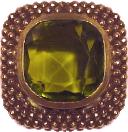 ACCESSOCRAFT The Accessocraft Products Corp. is a company that produces costume jewelry, belts, buttons, and other accesories in a variety of styles. Accessocraft was founded in 1935 in New York, NY, USA. |
ACROITE Acroite is a rare, colorless variety of tourmaline. |
 ACRYLIC Acrylics are a type of thermoplastic, and include transparent and opaque in varied colors. Some commonly-known acrylics are lucite and plexiglas. The bangle above is made of confetti lucite. |
ADAMANTINE Adamantine means having a luster like that of a diamond. |
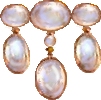 ADULARIA Adularia is a common type of moonstone, a whitish-bluish semi-translucent stone. Adularia is usually set as a cabochon. Adularia was very popular early in the 20th century and was extensively used in Art Nouveau jewelry. Adularia has a hardness of 6 and a specific gravity of 2.57. |
ADVENTURINE Adventurine is a misspelling of aventurine (and sometimes known as goldstone) is a shimmering quartz stone that ranges in color from yellow to red to light green to light brown. The shimmer is caused by tiny metallic particles (mica) within the stone. |
AFRICAN EMERALD African emerald is a misnomer for green fluorspar that is mined in South Africa; it is not an emerald at all. |
AFRICAN JADE African jade (also called Transvaal jade) is a misnomer for massive green grossular garnet that is mined in South Africa; it is not jade, but does look like jade. It can be light green, white, or pink |
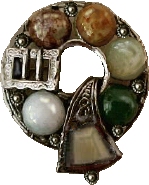 AGATE Agate is a variety of chalcedony (a family of microcrystalline quartz). Agate is a very common stone that is often used in jewelry. It is found in a wide range of colors, including black, gray, brown, reddish, green, pink, blue, and yellow. Agate can be flecked with color and is often banded, exhibiting layers of quartz. Agate is porous and takes dye easily; it is frequently dyed to enhance the coloration and the banding. White agate was used often in Victorian jewelry, mostly as a background. Moss agate has green, red or black dendritic inclusions. Onyx is agate whose bands are parallel. Eye agate has banding arranged in concentric circles. Agate has a hardness of 6.5 to 7 and a specific gravity of 2.6. The agate pin above is from Miracle. |
AIGRETTE An aigrette (meaning "egret" in French) is a feather-shaped piece of jewelry that is worn in the hair or on a hat. |
ALEXANDRITE Alexandrite is a mineral (a type of chrysoberyl) that appears to be different colors depending on whether it is viewed in natural or artificial light. Alexandrite appears to be red when seen in candle light and blue to green when seen in fluorescent light. Alexandrite was discovered on the birthday of the Russian Czar Alexander II, and it was named in his honor. Alexandrite is mined in Russia, Brazil, Burma, Ceylon, and Rhodesia. Laboratory-produced alexandrite is common, and it is often sold as natural alexandrite. Alexandrite has a hardness of 8.5 and a specific gravity of 3.64-3.74. |
ALEXANDRITE EFFECT The "Alexandrite Effect" is a phenomenon in which a stone appears to be different colors depending upon the type of light it is viewed in. For example, the stone alexandrite appears to be red when seen in candle light and blue to green when seen in fluorescent light. Many other stones exhibit the "Alexandrite Effect," including garnet and sapphire. |
 ALICE Alice is a costume jewelry mark used by the Alice Jewelry Company of Providence, Rhode Island. The Alice mark was first used around May, 1950. Alice pieces are relatively rare. They are NOT made by Alice Caviness. The intricate Alice earring above is gold-plated with enamel and tiny pearls. |
ALLOY An alloy is a combination of two or more metals. Common alloys used in jewelry are: gold under 24 Kt (mixed with silver, copper, and/or other metals), sterling silver (92.5% silver, 7.5% copper), brass (roughly half copper, half zinc), bronze (at least 60% copper with tin and perhaps other metals), and pewter (tin, lead, antimony, and a bit of silver or copper). |
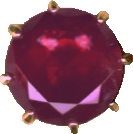 ALMANDINE Almandine is a type of violet-tinged variety of garnet that ranges in color from deep red to reddish-brown. Almandine is the most common kind of garnet. Star garnets are almandines that exhibit an asterism. Almandine has a hardness of 7.5 and a specific gravity of 3.85-4.20. |
ALPACA Alpaca (also spelled alpacca) is an alloy consisting of mostly copper (roughly 60 percent), and approximately 20 percent nickel, about 20 percent zinc, and about 5 percent tin. This metal is a a silver substitute. |
 ALUMINUM Aluminum is a lightweight, silver-white metal. When aluminum was first discovered in the 18th century, it was more valuable than gold. Now inexpensive, aluminum is used in many alloys. Some inexpensive jewelry was made using aluminum. |
AMAZONITE Amazonite is an iridescent stone that ranges in color from green to blue-green. Its composition is potassium aluminosilicate (KAlSi3O8), and is a type of feldspar (a green variety of microcline). Amazonite is usually set as a cabochon (since it breaks easily if faceted). This mineral was named for the Amazon River, where it was first thought to be found in the middle 1800s (the mineral found in the Amazon was actually a form of jadeite). Amazonite is also found in the Ural Mountains of Russia, in Colorado and Virginia, USA, Russia, Australia, and Africa. Amazonite has a hardness of 6 and a specific gravity of 2.56-2.58. Most Amazonite is opaque, but rare crystals are transparent. |
 AMBER Amber is translucent fossilized tree resin (from conifers), a natural hydrocarbon that comes in many colors, including yellow, reddish, whitish, black, and blue. Amber is flammable. Rubbing amber produces static electricity. The word electricity comes from the Greek word for amber, "elektron." It used to be thought that amber possessed magical powers that protected the wearer from evil. Pressed amber consists of small pieces of amber that have been fused together to form a larger piece. Fake amber is easily made from plastics, and buyers must beware of cheap imitations sold as natural amber. Amber has a hardness of 2.5 and a specific gravity of 1.05-1.10. |
AMERICAN RUBY The term "American ruby" is actually a pyrope garnet (and not a ruby at all). There are real rubies found in the US, but they are not referred to as "American rubies." |
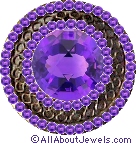 AMETHYST Amethyst (Greek for "not drunken") is a form of the mineral quartz, and is a relatively common gemstone. Amethyst is usually purple, but can range in color from pale lavender to a very deep, reddish purple to a milky color to green. Deeper-colored amethysts are more highly valued. The ancient Greeks believed that amethyst made one immune to the effects of alcohol. Synthetic amethysts are hard to distinguish from the real stone. |
AMETRINE Ametrine is a variety of quartz, a mixture of amethyst and citrine. Ametrine is partially purple and partially orange-yellow. |
AMMOLITE Ammolite (also known as korite, calcentine, or Buffalo Stone.) is a fossilized, opalized ammonite shell used as a gemstone (it is the shell of the ammonite, a fossilized marine animal, a cephalopod). It is a gray, iridescent stone with flashes of green, red, yellow, blue or purple (blues and purples are rare); the color changes as the stone is turned. Ammolite has a hardness of about 4 (it is very brittle before it is treated) and a specific gravity of 2.8. Ammolite is usually treated with a colorless, hard material to increase the strength of the stone and is often mounted as a doublet or a triplet (with a quartz top layer and a shale underside). Ammolite is only found in southern Alberta, Canada. |
AMORPHOUS Amorphous means without form. An amorphous gem, like jet, amber, or ivory, does not have a regular internal structure, like those gems that fall within the seven crystal systems. |
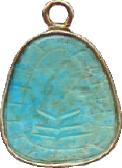 AMULET An amulet is a protective charm that is worn (like a bulla). It is worn in the hope of protecting the wearer from evil or illness or to bring the wearer good luck. The amulet above is turquoise with carved inscriptions, set in gold. |
 DAVID-ANDERSEN The David-Andersen Company is a jewelry company located in Oslo, Norway. This Scandinavian company produces high quality silver pieces with elegant designs, often with beautiful enamel work. The goldsmith David Anderson founded the company in 1876, in Christiania, Norway (now called Oslo). He soon expanded his company, making jewelry and table accessories (like flatware and tongs). Some designers for David-Anderson include Bjorn Sgurd Oster, Synnove Korssjoen (who designed for D-A during the 1960's), Millie Beherns, Konrad Mehus, and Nora Gulbrandsen (894-1978, who designed jewelry for the company in the 1960s). Marks from this company include "David-Andersen" and "D-A." |
ANGELITE Angelite (CaSO4); it is a pale blue variety of calicium sulfate = anhydrate (it is gypsum that has lost water and crystallized). The stone is quite brittle; crystals are transparent to transluscent. Angelite stone has a hardness of 3 to 3.5 (quite soft) and a specific gravity of 2.9 - 3.0. |
ANGELSKIN CORAL Angelskin coral is a pale pink coral, from deep sea coral. Angelskin coral is one of the most valued colors of coral (red is also highly prized). Coral is an animal that grows in colonies in the ocean. Coral polyps secrete a strong calcium structure that is used in jewelry making. Coral ranges in color from pale pink (called angelskin coral) to orange to red to white. In jewelry making, coral is either carved into beads, cameos, or other forms, or is left in its natural branch-like form and just polished. It used to be thought that coral protected the wearer, so it was a traditional gift to children. Coral has a hardness of about 3.5 and a specific gravity of 2.6 to 2.7. Since it is composed of calcium carbonate, coral will effervesce if touched with acid. Imitation coral is made from glass, porcelain, or plastic. |
ANNEALING Annealing is the process of heating a metal and then cooling it to make it more workable. As metal is worked (hammered, rolled, etc.), stresses make the metal brittle (the metal molecules are pulled into random structures during the working). Annealing the metal make the metal re-crystallize, putting the molecules in an orderly structure. The temperature (and amount of time it takes) for annealing a metal depends on what metal or alloy it is. Large pieces are annealed in an annealing oven; small pieces are annealed using a blow-torch. |
ANODIZED Anodized metal has been through an electrochemical process which changes the molecular structure of the surface layer, giving it a thin, protective film. In the anodization process, the metal is placed in an acid bath (at the "anode" or positive end of the electrical circuit) and an electrical current is passed through the tank. This process causes a controlled oxidation of the metal's surface to occur (oxygen atoms bond to surface atoms of the metal). Aluminum is often anodized, as is magnesium, titanium, and tantalum. Anodized metal has a lustrous sheen; the anodizing process can produce colorful surfaces. |
 APACHE TEARS Apache tears (a type of obsidian) is a volcanic glass that is usually black, but is occasionally red, brown, gray, green (rare), dark with "snowflakes," or even clear. This glassy, lustrous form of obsidian is found in lava flows in the southwest USA. Obsidian is formed when viscous lava (from volcanos) cools rapidly. Most obsidian is 70 percent silica. Obsidian has a hardness of 5 and a specific gravity of 2.35. The pin above is mahogany (brown) obsidian. |
APATITE Apatite (calcium phosphate) is a clear to opaque stone that comes in many colors, including green, yellow, blue, violet, and yellow-green (called asparagus stone). Some apatite stones show a cat's eye asterism. This stone is rarely used in jewelry because it is brittle and soft. Apatite comes from the Greek word for "deceit," because it was easily confused with other minerals. Apatite has a hardness of 5 and a specific gravity of 3.15-3.22. |
 APPLE JUICE Apple juice plastic is a translucent, golden yellow plastic is the color of apple juice. The bangle above is reverse-carved and painted in the areas that are carved. |
AQUA AURA Aqua aura is a beautiful iridescent bluish to clear stone that is made by coating clear quartz that with a fine layer of gold (or aluminium or copper). In a process called called vapor deposition, the quartz is put into a vacuum chamber and attached to very hot electrodes. A thin layer of the metal (only a micron or two thick) coats the quartz as the metal evaporates. |
AQUAMARINE Aquamarine is a transparent, light blue or sea-green stone that is porous. Today, blue aquamarines are more highly valued, but this was not true in the past, when sea-green stones were prized. Heat-treatment turns greenish stones bluer. The best aquamarines come from Brazil. Large aquamarines are relatively common. Aquamarines are usually faceted but when they are cabochon cut, a cat's eye effect or asterism may appear. Aquamarines belong to the beryl family of stones. Aquamarine has a hardness of 7.5-8 and a specific gravity of 2.65-2.85. |
AQUA REGIA Aqua regia is a 3:1 mixture of hydrochloric acid and nitric acid. Aqua regia is used to test gold and platinum; it is one of the few substances that can dissolve gold and platinum. |
ARAGONITE Aragonite is a mineral that is rarely used for jewelry. It is transparent to translucent and can range in color from honey-colored to pale reds, blues and greens to clear or white. It forms hexagonal crystals, pyramidal crystals, chisel shaped crystals, and other shapes. Aragonite has a hardness of 3.5-4 (relatively soft) and a specific gravity of 2.9 g/cm3.(average). Its chemical composition is CaCO3 (it is a form of Calcium Carbonate). Aragonite is named for Aragon, Spain, where it was first found in 1790. Aragonite is also found in many other European, North African, and some North American locations. |
ARCADE SETTING An arcade setting (also called coronet or châton setting) is one in which the stone is held in by many metal claws around a metal ring. |
ARCTIC OPAL Arctic opal is a blue-green stone that is a mixture of azurite and malachite; it is not a type of opal at all. Arctic opal is mined in the Wrangle Mountains and the Chugach Mountains of Alaska, USA (near Anchorage). |
ARIZONA RUBY An Arizona ruby is actually a pyrope garnet (and not a ruby at all). |
ARIZONA SPINEL An Arizona spinel is actually a garnet (and not a spinel at all). |
ARKANSAS DIAMOND An Arkansas diamond is actually a rock crystal (and not a diamond at all). |
ARKANSAS STONE Arkansas stone is an abrasive used in jewelry making. It is used to smooth metals. |
ARTS AND CRAFTS Arts and Crafts was an artistic movement that produced hand-crafted pieces toward the end of the 1800's. Pieces purposely look hand-made, incorporating hammer marks and simple cabochon settings. The Arts and Crafts movement also revived the art of enamel. A prominent Arts and Crafts jeweller was C.R. Ashbee (1863-1942); Ashbee founded The Guild of Handicraft in 1888. Other important Arts and Crafts jewelers included Arthur Gaskin (1862-1928), Georgina Gaskin (1868-1934, Arthur's wife), Fred T. Partridge, John Paul Cooper (1869-1933), Bernard Cuzner (1877-1956), Henry Wilson (1864-1934), Alexander Fisher (1864-1936), and Edgar Simpson. |
ASSAY An assay is a test of the purity of an alloy. A tiny piece of metal is scraped from the piece and the percentage of gold or silver is determined. Official assay offices determine whether a piece qualifies for an appropriate hallmark. |
ASSCHER, JOSEPH Joseph Asscher was an eminent diamond cutter who cut the 3,106 carat Cullinan diamond. Asscher worked in Amsterdam. In 1902, his company, the Asscher Diamond Co., developed and patented the Asscher cut, a squarish step cut with an almost octagonal outline. This new cut enhanced the fire and light of the stone; it had a small table, a high crown, wide step facets, a deep pavilion and square culet. This cut became very popular in Art Deco jewelry and was a forerunner of the emerald cut. Recently, the Royal Asscher Diamond Co. resumed production of the original Asscher cut diamonds. |
ASTERISM An asterism is a star-like luminous effect that reflects light in some gemstones, like star sapphires and star garnets. |
 AURORA BOREALIS Aurora borealis (meaning "northern lights") rhinestones have a special iridescent finish that shines with many colors. The iridescent surface is a result of a very thin layer of metallic atoms that have been deposited on the lower surface of the stone. This process was invented in 1955 by the Swarovski company together with Christian Dior. |
AUSTRALIAN RUBY An Australian ruby is actually a pyrope garnet (and not a ruby at all). |
AVENTURINE Aventurine (sometimes known as goldstone and sometimes mis-spelled adventurine) is a shimmering quartz stone that ranges in color from yellow to red to light green to light brown. The shimmer is caused by tiny metallic particles (mica) within the stone. |
AVENTURINE FELDSPAR Aventurine feldspar is also called Sunstone (a variety of oligoclase). This gemstone varies from golden to orange to red-brown, and can be transparent or translucent. Sunstone is metallic-looking due to sparkling red, orange or green crystalline inclusions (these are hematite or goethite crystals). Sunstone is found in Canada, the USA (in Oregon), India, Norway, and Russia. This brittle stone has a hardness of 6 and a specific gravity of 2.63 - 2.67. Sunstone is not enhanced. |
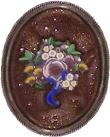 AVENTURINE GLASS Aventurine glass (sometimes spelled adventurine glass) is a shimmering glass that contains tiny metallic particles (copper flakes) within it. The process of making aventurine glass was invented in Venice, Italy, around 1700. |
AVENTURINE QUARTZ Aventurine quartz is a type of quartz that has sparkling flecks (includions) of mica or iron. This colors of this stone include red-brown, yellow, gray, and green. Aventurine quartz has a hardness of 7 and a specific gravity of 2.64-2.69. This stone is usually cut with a flat or rounded surface to maximize its sparkle. Aventurine quartz is found in India, Russia, and Tanzania. |
 AVON The Avon cosmetics company also produced many lines of jewelry, beginning in the 1970's. Avon jewelry includes figurals, perfume-holding pins, watches, and standard items of costume jewelry. The quality of these pieces ranges from cheaply-made to very good; they were produced in large quantities. Many people collect Avon items. The Avon flower pin above has a faux coral flower. |
AWABI PEARL The Japanese name for abalone pearls is Awabi pearls. |
AXINITE Axinite is an unusual, lustrous stone that is brown, yellow, blue, green or gray. Violet axinite is rare (and from Tasmania). It has both transparent and translucent varieties. Axinite is dichroic. Axinite has a hardness of 7 and a specific gravity of 3.3. Axinite is a boro-silicate of aluminum and calcium. It is used only as a mineral specimen and not in jewelry. |
 AXIS OF SYMMETRY An axis of symmetry (also called a rotational axis) is an imaginary line around which an object can be rotated a certain number of degrees and look like the original shape. When two planes of symmetry intersect, they form a straight line, which is an axis of symmetry. See more in the entry on crystal systems |
 AZURITE Azurite is a beautiful copper-based blue mineral that is often used in jewelry. The color ranges from very deep blue to pale blue. Azurite has also been used as a dye for paints and luxury fabrics. Azurite is hydrated copper carbonate; its chemical formula is Cu3(CO3)2(OH)2. Malachite (another copper-based mineral) and azurite are often found together. Azurite has a hardness of 3.5 to 4 (relatively soft) and a specific gravity of 3.7 to 3.9. Azurite is found in massive monoclinic crystals in Australia the southwestern USA, France, Mexico, Morocco, Nambia, Zaire, and Europe. Azurite is sometimes coated with a colorless wax or impregnated with plastic in order to enhance the color and increase the hardness. |
Illustrated Dictionary of Jewelry |
 |
||||||
| A | B | C | D | E | F | G | H | I | J | K | L | M | N | O | P | Q | R | S | T | U | V | W | X | Y | Z |
Enchanted Learning®
Over 35,000 Web Pages
Sample Pages for Prospective Subscribers, or click below
|
Overview of Site What's New Enchanted Learning Home Monthly Activity Calendar Books to Print Site Index K-3 Crafts K-3 Themes Little Explorers Picture dictionary PreK/K Activities Rebus Rhymes Stories Writing Cloze Activities Essay Topics Newspaper Writing Activities Parts of Speech Fiction The Test of Time
|
Biology Animal Printouts Biology Label Printouts Biomes Birds Butterflies Dinosaurs Food Chain Human Anatomy Mammals Plants Rainforests Sharks Whales Physical Sciences: K-12 Astronomy The Earth Geology Hurricanes Landforms Oceans Tsunami Volcano |
Languages Dutch French German Italian Japanese (Romaji) Portuguese Spanish Swedish Geography/History Explorers Flags Geography Inventors US History Other Topics Art and Artists Calendars College Finder Crafts Graphic Organizers Label Me! Printouts Math Music Word Wheels |
Click to read our Privacy Policy
| Search the Enchanted Learning website for: |